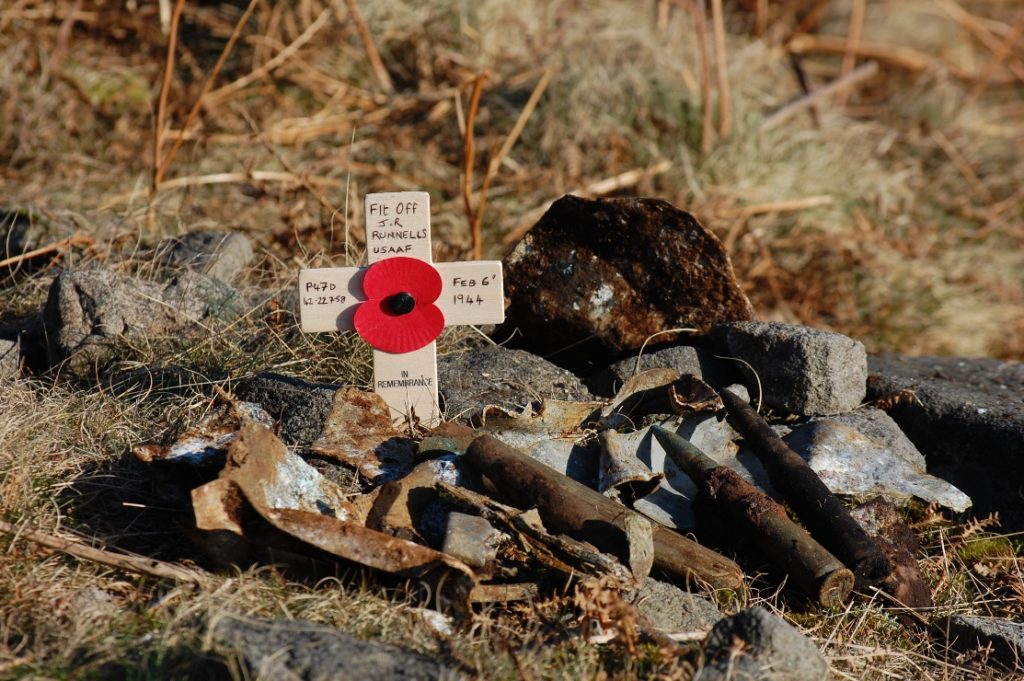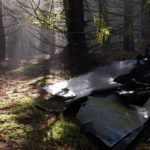P-47D Thunderbolt 42-22758 crash site on Pendle Hill
‹ Return to Air Crash Sites

P-47D Thunderbolt 42-22758 crash site on Pendle Hill
On February 6th 1944, 5 American P-47 Thunderbolts were flying from East Wretham in Norfolk, to Warton near Preston. They had taken off in spite of a warning of bad weather over Lancashire.
Two pilots, Captain Charles Francis (Flight leader) and Flight Officer John Runnells were killed. Capt. Francis’ Thunderbolt had crashed on approach to Warton, while Flt Off Runnells crashed here on Pendle Hill. It would appear he had run out of fuel while circling in the hope of getting a break in the cloud and obtaining a visual fix.
At the site were some 50 caliber rounds with blue incendiary tips. Visible on one of these was a fragment of the machine gun belt (there were 4 guns in each wing). Paul also found the copper plated antenna mast.
Photo taken just after the crash. Note the tail section on the left.

The bullet holes in this fragment show the wreck would have been used for target practice, Pendle Hill being used as a training ground by the army during the war.

18 comments on “P-47D Thunderbolt 42-22758 crash site on Pendle Hill”
Leave a Reply to andyholmfirth Cancel reply
Image Information
-
Full Size: 1113×740px
Aperture: f/10
Focal Length: 110mm
ISO: 200
Shutter: 1/320 sec
Camera: NIKON D40



Crikey ! I’m amazed the old live ammo has been left kicking around. So much for health and safety !
i wonder Ian does anyone know how many lads lost their lives in crashes during the War?
Aircraft wreckage the country over all have the same characteristics, you just need a quick glimpse of the metalwork to know to know that it has came from an aircraft.
Like the poppey amongst the wreckage
nice one again ian ,
Thanks all.
[http://www.flickr.com/photos/solarscot/]
John, that’s a good question and one I keep meaning to find an answer to, or at least as close as you could get. To give you some idea though, RAF Bomber Command total aircrew losses during the war was 55,573 men. That figure includes all lost on operations overseas and on non-operational flights but doesn’t include US airmen stationed in UK or non-bomber crews.
As for the numbers of aircraft that crashed in the UK, the English Heritage document Military Aircraft Crash Sites states that RAF Bomber Command losses in the UK, whether on operations or not, was 5366 aircraft written off. But that’s just the bombers.
That document summarises that between 1939 and 1945, a total of about 10,000 planes crashed in the UK. This figure includes aircraft of all types and nationalities. I don’t know how many crewmen that meant though.
That figure also does not include civilian losses or pre and post war losses. People in Britain are never far from these places.
Missed this … Great use of DOF Ian , and the usual superb information.
The thread also is very interesting , thanks everyone for the questions and contributions.
I always find your information very interesting!
Sorry Ian, missed this one somehow.. Never knew so many airmen were lost during the war. Amazed that you found live ammo.
Superb presentation Ian.
Great history lesson… tragic though. As my dad was a pilot in WW!! I have some nice old photos of planes and crashes…
This is very awesome – thanks for sharing!
Wow!
Lovely shot !!
Just stumbled across your photostream and have found it absolutely fascinating. Not only are your photographs really good but I’m amazed at the amount of information you include. Great stuff.
Did you remove the live rounds and give them to the police? I know crashes like these should be considered graves and I’d never dream of removing bits, but live ammo?
Hehe , I cannot imagine the local police patting anyone on the back for handing in old unstable ammo at the local copshop.
Might end up with a ticking off from every direction. 🙂
Re the question about numbers of men killed in accidents , its almost impossible to tell without going through every event including the huge amount of airfield accidents but the RAF bomber command lost 3986 aircraft on non operational flights ,and another 1430 in the UK on operations whilst the USAAF lost 1084 in accidents in the UK . If you add these figures up and make a cursory assumption that an average of 5 men were killed for each crash ( obviously the figure varies for each event between 0 and all the crew , some aircraft had passengers too) you arrive at a figure of around 30,000 men lost in the UK , around 25,000 of whom will have been lost not on operations.
These are numbers the size of which are difficult to comprehend .
This doesnt include figures for the RAF Fighter Command which will also be significant .
[http://www.flickr.com/photos/pasujoba44] Actually the police were very pleased with the handgun, 50 boxed rounds and a few loose .44 rounds I reported after finding them in a bush 🙂
Is there actually a site map of the crash site.
I don’t have a map showing it Peter but the crash site is at approx grid ref SD 780 399, on the northern slope of Ashdean Clough with debris found down the slope by Howcroft Brook.